Purification of Waste Graphite from Crucibles Used in Photovoltaic Crystallization by an Alkali-Acid Method
Abstract
1. Introduction
2. Materials and Methods
2.1. Materials and Chemicals
2.2. Purification Methods of WG Powders
3. Results and discussion
3.1. Analysis of Impurity Element Contents and Occurrence State of Raw Materials
3.2. Impurity Traceability and Content Determination of Silicon Carbide
3.3. Effect of Purification Parameters on the Removal Efficiency of Impurities
3.3.1. Effect of Alkali Roasting Parameters on Purification Efficiency
3.3.2. Effect of Acid Leaching Parameters on Purification Efficiency
- The volatility of concentrated hydrochloric acid led to the partial loss of hydrochloric acid. Increasing the concentration also reduced the liquid–solid ratio, which affected the reaction of impurities with hydrochloric acid, and ultimately reduced the graphite fixed carbon content.
- HCl reacted with the residual Na2SiO3 to form metasilicic acid, which hindered the filtration effect and reduced the removal efficiency via Equation (6):
3.4. Analysis of Products Purified by the Alkali-Acid Method
3.5. Analysis of Impurity Element Migration during Removal
4. Conclusions
Author Contributions
Funding
Data Availability Statement
Acknowledgments
Conflicts of Interest
References
- Angelopoulos, P.M.; Koukoulis, N.; Anastassakis, G.N.; Taxiarchou, M.; Paspaliaris, I. Selective recovery of graphite from spent potlining (SPL) by froth flotation. J. Sustain. Metall. 2021, 7, 1589–1602. [Google Scholar] [CrossRef]
- Bao, C.; Shi, K.; Xu, P.; Yang, L.; Chen, H.; Dai, Y.; Liu, H. Purification effect of the methods used for the preparation of the ultra-high purity graphite. Diam. Relat. Mater. 2021, 120, 108704. [Google Scholar] [CrossRef]
- Bhola, S.M.; Kundu, S.; Alabbas, F.; Mishra, B.; Olson, D.L. An electrochemical study on chlorhexidine gluconate addition to normal saline for oral implant applications. Int. J. Electrochem. Sci. 2013, 8, 5172–5182. [Google Scholar] [CrossRef]
- Bouchetou, M.; Poirier, J.; Morales, L.A.; Chotard, T.; Joubert, O.; Weissenbacher, M. Synthesis of an innovative zirconia-mullite raw material sintered from andalusite and zircon precursors and an evaluation of its corrosion and thermal shock performance. Ceram. Int. 2019, 45, 12832–12844. [Google Scholar] [CrossRef]
- Chehreh Chelgani, S.; Rudolph, M.; Kratzsch, R.; Sandmann, D.; Gutzmer, J. A review of graphite beneficiation techniques. Miner. Process. Extr. Metall. Rev. 2016, 37, 58–68. [Google Scholar] [CrossRef]
- Dhal, B.; Thatoi, H.N.; Das, N.N.; Pandey, B.D. Chemical and microbial remediation of hexavalent chromium from contaminated soil and mining/metallurgical solid waste: A review. J. Hazard. Mater. 2013, 250–251, 272–291. [Google Scholar] [CrossRef]
- Ding, S.; Sun, S.; Xu, H.; Yang, B.; Liu, Y.; Wang, H.; Chen, D.; Zhang, R. Preparation and adsorption property of graphene oxide by using waste graphite from diamond synthesis industry. Mater. Chem. Phys. 2019, 221, 47–57. [Google Scholar] [CrossRef]
- Jalili, R.; Esrafilzadeh, D.; Aboutalebi, S.H.; Sabri, Y.M.; Kandjani, A.E.; Bhargava, S.K.; Della Gaspera, E.; Gengenbach, T.R.; Walker, A.; Chao, Y. Silicon as a ubiquitous contaminant in graphene derivatives with significant impact on device performance. Nat. Commun. 2018, 9, 5070. [Google Scholar] [CrossRef]
- Jara, A.D.; Betemariam, A.; Woldetinsae, G.; Kim, J.Y. Purification, application and current market trend of natural graphite: A review. Int. J. Min. Sci. Technol. 2019, 29, 671–689. [Google Scholar] [CrossRef]
- Li, B.; Wu, C.; Xu, J.; Hu, D.; Zhang, T.; Fang, X.; Tong, J. One-pot redox synthesis of graphene from waste graphite of spent lithium ion batteries with peracetic acid assistance. Mater. Chem. Phys. 2020, 241, 122397. [Google Scholar] [CrossRef]
- Li, Y.-F.; Zhu, S.-F.; Wang, L. Purification of natural graphite by microwave assisted acid leaching. Carbon 2013, 55, 377–378. [Google Scholar] [CrossRef]
- Lu, X.; Forssberg, E. Preparation of high-purity and low-sulphur graphite from Woxna fine graphite concentrate by alkali roasting. Miner. Eng. 2002, 15, 755–757. [Google Scholar] [CrossRef]
- Ma, Y.; Wang, X.; Stopic, S.; Wang, M.; Kremer, D.; Wotruba, H.; Friedrich, B. Preparation of vanadium oxides from a vanadium (IV) strip liquor extracted from vanadium-bearing shale using an eco-friendly method. Metals 2018, 8, 994. [Google Scholar] [CrossRef]
- Natarajan, S.; Aravindan, V. An urgent call to spent LIB recycling: Whys and wherefores for graphite recovery. Adv. Energy Mater. 2020, 10, 2002238. [Google Scholar] [CrossRef]
- Ni, B.J.; Huang, Q.S.; Wang, C.; Ni, T.Y.; Sun, J.; Wei, W. Competitive adsorption of heavy metals in aqueous solution onto biochar derived from anaerobically digested sludge. Chemosphere 2019, 219, 351–357. [Google Scholar] [CrossRef]
- Peng, W.; Li, H.; Hu, Y.; Liu, Y.; Song, S. Does silicate mineral impurities in natural graphite affect the characteristics of synthesized graphene Mater. Res. Bull. 2016, 74, 333–339. [Google Scholar] [CrossRef]
- Quan, Y.; Liu, Q.; Li, K.; Zhang, H.; Yuan, L. Highly efficient purification of natural coaly graphite via an electrochemical method. Sep. Purif. Technol. 2022, 281, 119931. [Google Scholar] [CrossRef]
- Rey, I.; Vallejo, C.; Santiago, G.; Iturrondobeitia, M.; Lizundia, E. Environmental impacts of graphite recycling from spent lithium-ion batteries based on life cycle assessment. ACS Sustain. Chem. Eng. 2021, 9, 14488–14501. [Google Scholar] [CrossRef]
- Shen, K.; Huang, Z.-H.; Hu, K.; Shen, W.; Yu, S.; Yang, J.; Yang, G.; Kang, F. Advantages of natural microcrystalline graphite filler over petroleum coke in isotropic graphite preparation. Carbon 2015, 90, 197–206. [Google Scholar] [CrossRef]
- Wang, H.; Feng, Q.; Tang, X.; Liu, K. Preparation of high-purity graphite from a fine microcrystalline graphite concentrate: Effect of alkali roasting pre-treatment and acid leaching process. Sep. Sci. Technol. 2016, 51, 2465–2472. [Google Scholar] [CrossRef]
- Xie, W.; Wang, Z.; Kuang, J.; Xu, H.; Yi, S.; Deng, Y.; Cao, T.; Guo, Z. Fixed carbon content and reaction mechanism of natural microcrystalline graphite purified by hydrochloric acid and sodium fluoride. Int. J. Miner. Process. 2016, 155, 45–54. [Google Scholar] [CrossRef]
- Zaghib, K.; Song, X.; Guerfi, A.; Rioux, R.; Kinoshita, K. Purification process of natural graphite as anode for Li-ion batteries: Chemical versus thermal. J. Power Sources 2003, 119, 8–15. [Google Scholar] [CrossRef]
- Nakamura, D.; Shigetoh, K. Fabrication of large-sized TaC-coated carbon crucibles for the low-cost sublimation growth of large-diameter bulk SiC crystals. Jpn. J. Appl. Phys. 2017, 56, 085504. [Google Scholar] [CrossRef]
- Duan, S.-Z.; Wu, X.-W.; Wang, Y.-F.; Feng, J.; Hou, S.-Y.; Huang, Z.-H.; Shen, K.; Chen, Y.-X.; Liu, H.-B.; Kang, F.-Y. Recent progress in the research and development of natural graphite for use in thermal management, battery electrodes and the nuclear industry. New Carbon Mater. 2023, 38, 73–95. [Google Scholar] [CrossRef]
- Park, K.H.; Lee, D.; Kim, J.; Song, J.; Lee, Y.M.; Kim, H.; Park, J. Defect-Free, Size-Tunable Graphene for High-Performance Lithium Ion Battery. Nano Lett. 2014, 14, 4306–4313. [Google Scholar] [CrossRef] [PubMed]
- Chen, K.; Song, S.; Liu, F.; Xue, D. Structural Design of Graphene for Use in Electrochemical Energy Storage Devices. Chem. Soc. Rev. 2015, 44, 6230–6257. [Google Scholar] [CrossRef] [PubMed]
- Tian, R.; Wang, W.; Huang, Y.; Duan, H.; Guo, Y.; Kang, H.; Li, H.; Liu, H. 3D Composites of Layered MoS2 and Graphene Nanoribbons for High Performance Lithium-Ion Battery Anodes. J. Mater. Chem. A 2016, 4, 13148–13154. [Google Scholar] [CrossRef]
- Tian, R.; Zhang, Y.; Chen, Z.; Duan, H.; Xu, B.; Guo, Y.; Kang, H.; Li, H.; Liu, H. The Effect of Annealing on a 3D SnO2/Graphene Foam as an Advanced Lithium-Ion Battery Anode. Sci. Rep. 2016, 6, 19195. [Google Scholar] [CrossRef]
- Chen, K.; Xue, D.; Komarneni, S. Nanoclay Assisted Electrochemical Exfoliation of Pencil Core to High Conductive Graphene Thin-Film Electrode. J. Colloid Interface Sci. 2017, 487, 156–161. [Google Scholar] [CrossRef]
- Gu, J.N.; Du, Z.G.; Zhang, C.; Yang, S.B. Pyridinic Nitrogen-Enriched Carbon Nanogears with Thin Teeth for Superior Lithium Storage. Adv. Energy Mater. 2016, 6, 1600917. [Google Scholar] [CrossRef]
- Chen, K.; Xue, D.; Komarneni, S.; Liu, F. Carbon with Ultrahigh Capacitance when Graphene Paper Meets K3Fe(CN)6. Nanoscale 2015, 7, 432–439. [Google Scholar] [CrossRef] [PubMed]
- Yu, M.; Lin, D.; Feng, H.; Zeng, Y.; Tong, Y.; Lu, X. Boosting Energy Density of Carbon Based Aqueous Supercapacitors via Optimizing Surface Charge. Angew. Chem. Int. Ed. 2017, 56, 5454–5459. [Google Scholar] [CrossRef] [PubMed]
- Yu, M.; Zhao, S.; Feng, H.; Hu, L.; Zhang, X.; Zeng, Y.; Tong, Y.; Lu, X. Engineering Thin MoS2 Nanosheets on TiN Nanorods: Advanced electrochemical capacitor electrode and hydrogen evolution electrocatalyst. ACS Energy Lett. 2017, 2, 1862–1868. [Google Scholar] [CrossRef]
- Rothermel, S.; Evertz, M.; Kasnatscheew, J.; Qi, X.; Grutzke, M.; Winter, M.; Nowak, S. Graphite Recycling from Spent Lithium-Ion Batteries. ChemSusChem 2016, 9, 3473–3484. [Google Scholar] [CrossRef]
- Placke, T.; Siozios, V.; Schmitz, R.; Lux, S.F.; Bieker, P.; Colle, C.; Meyer, H.W.; Passerini, S.; Winter, M. Influence of Graphite Surface Modifications on the Ratio of Basal Plane to “Non-Basal Plane” Surface Area and on the Anode Performance in Lithium Ion Batteries. J. Power Sources 2012, 200, 83–91. [Google Scholar] [CrossRef]
- Zvereva, E.; Caliste, D.; Pochet, P. Interface Identification of the Solid Electrolyte Interphase on Graphite. Carbon 2017, 111, 789–795. [Google Scholar] [CrossRef]
- Zouboulis, A.I.; Tzoupanous, N.D. Polyaluminium silicate chloride—A systematic study for the preparation and application of an efficient coagulant for water or wastewater treatment. J. Hazard. Mater. 2009, 162, 1379–1389. [Google Scholar] [CrossRef] [PubMed]
- Yang, Z.L.; Gao, B.Y.; Yue, Q.Y.; Wang, Y. Effect of pH on the coagulation performance of Al-based coagulants and residual aluminum speciation during the treatment of humic acid–kaolin synthetic water. J. Hazard. Mater. 2010, 178, 596–600. [Google Scholar] [CrossRef]
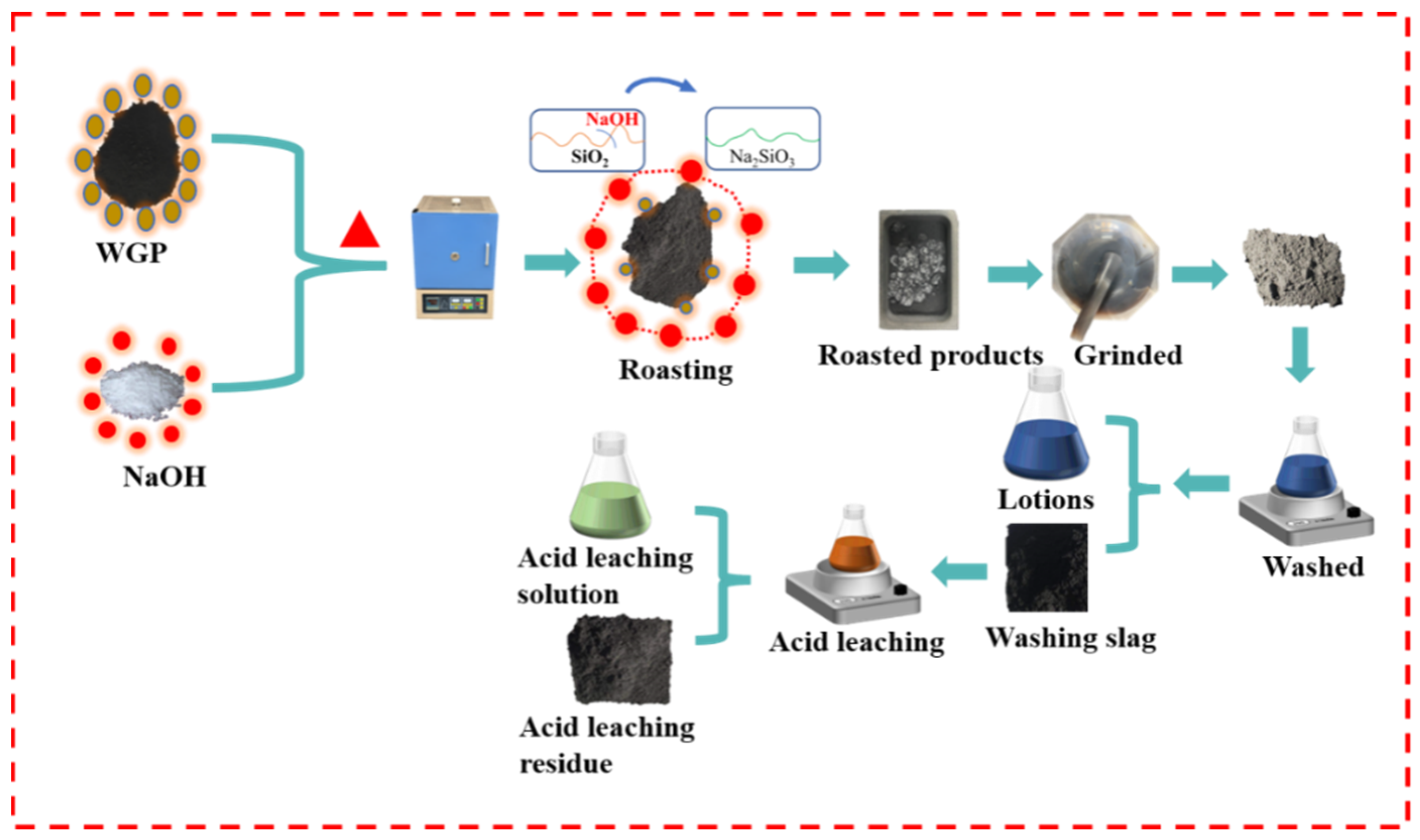
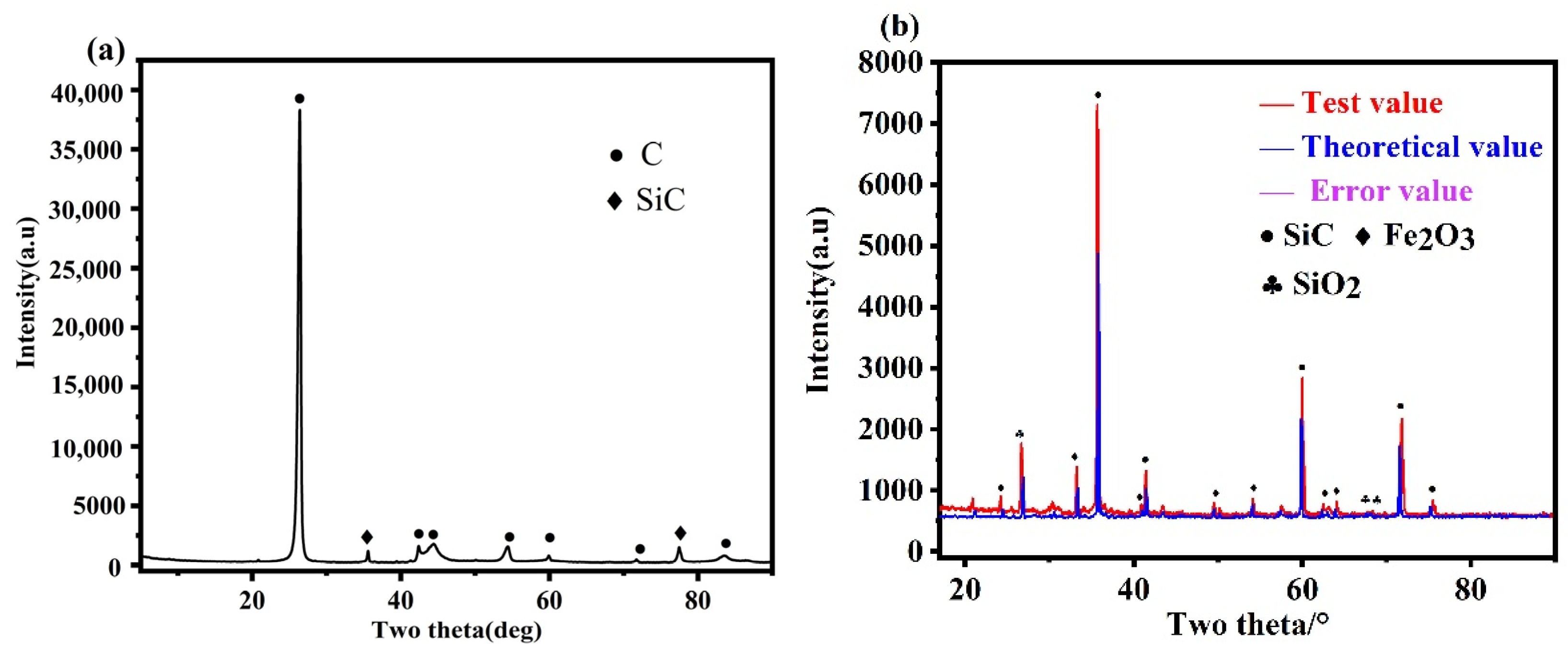
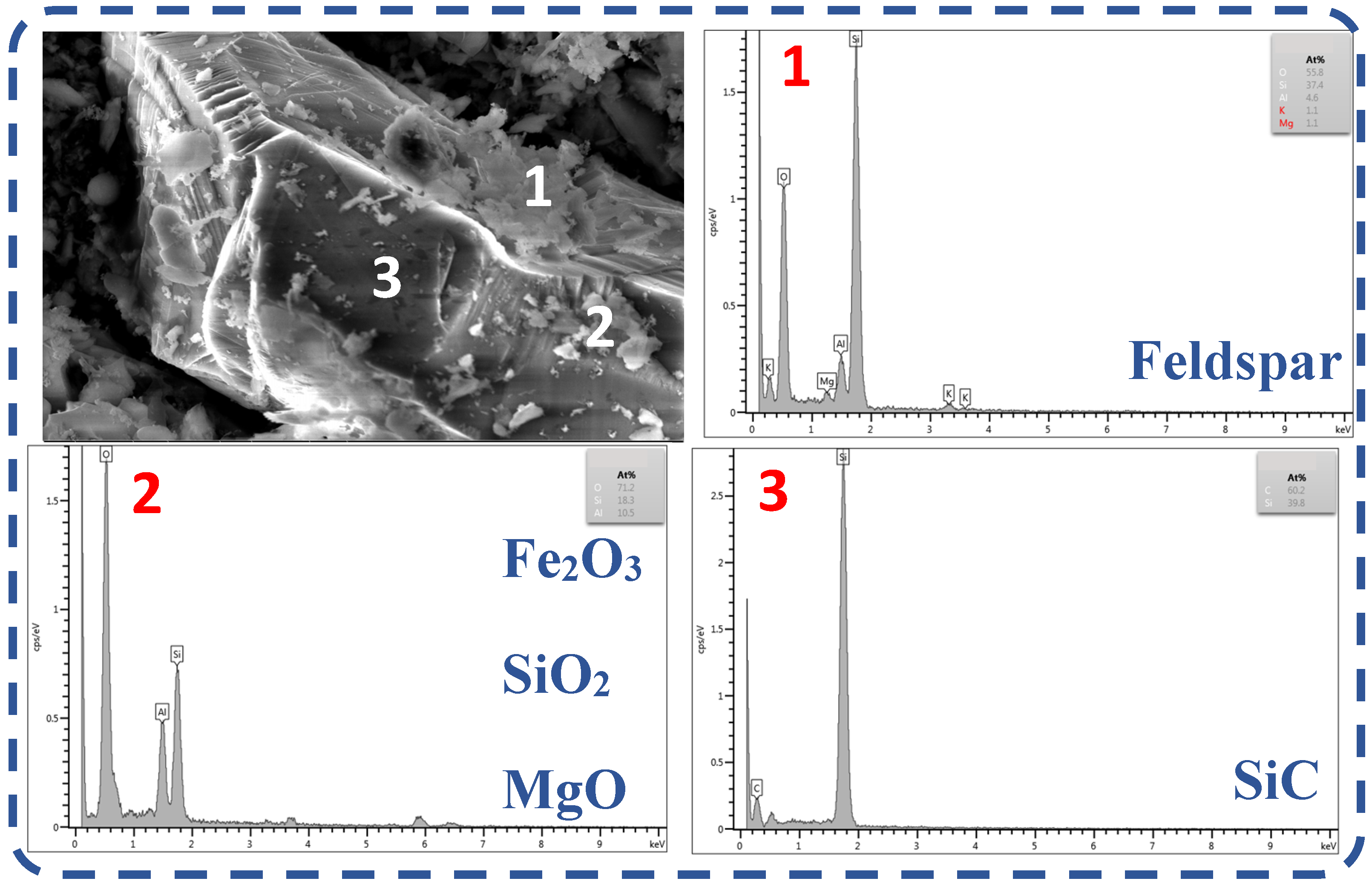
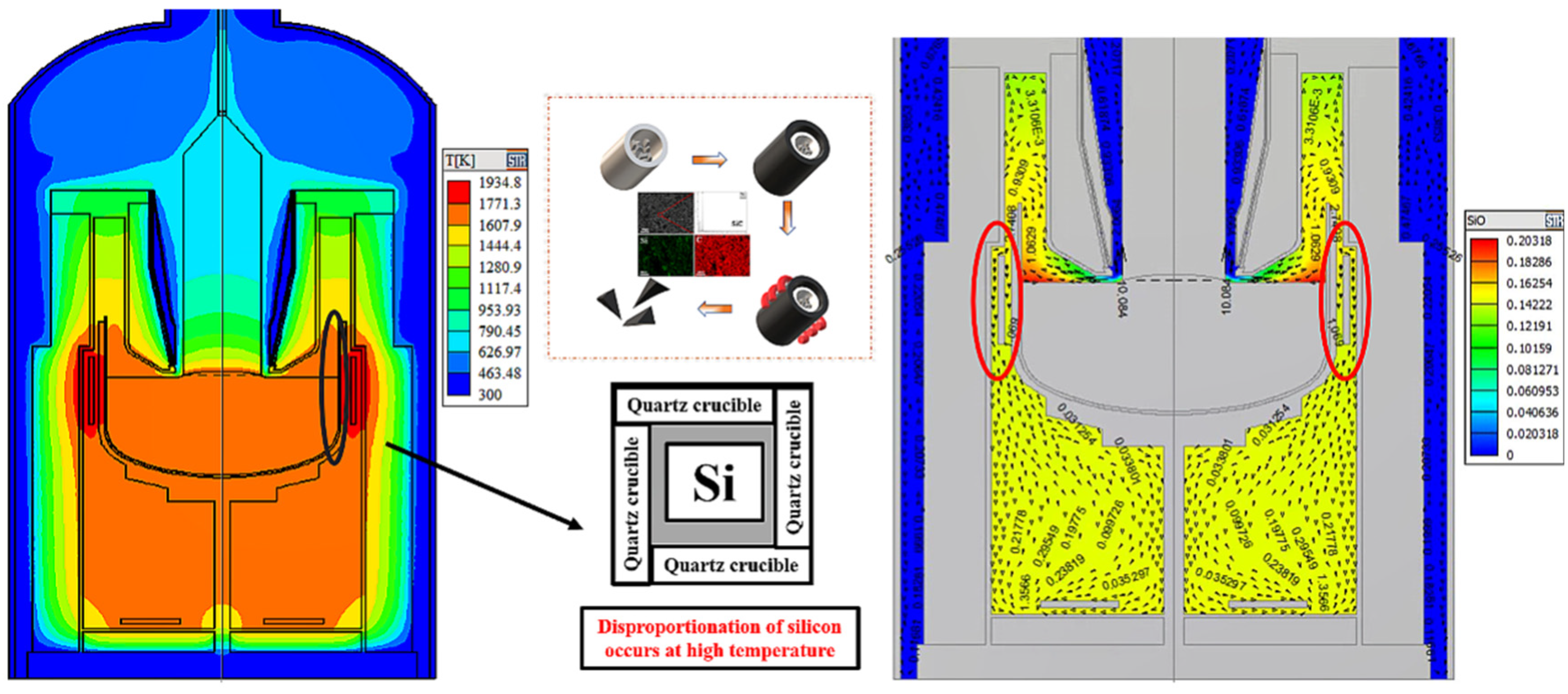
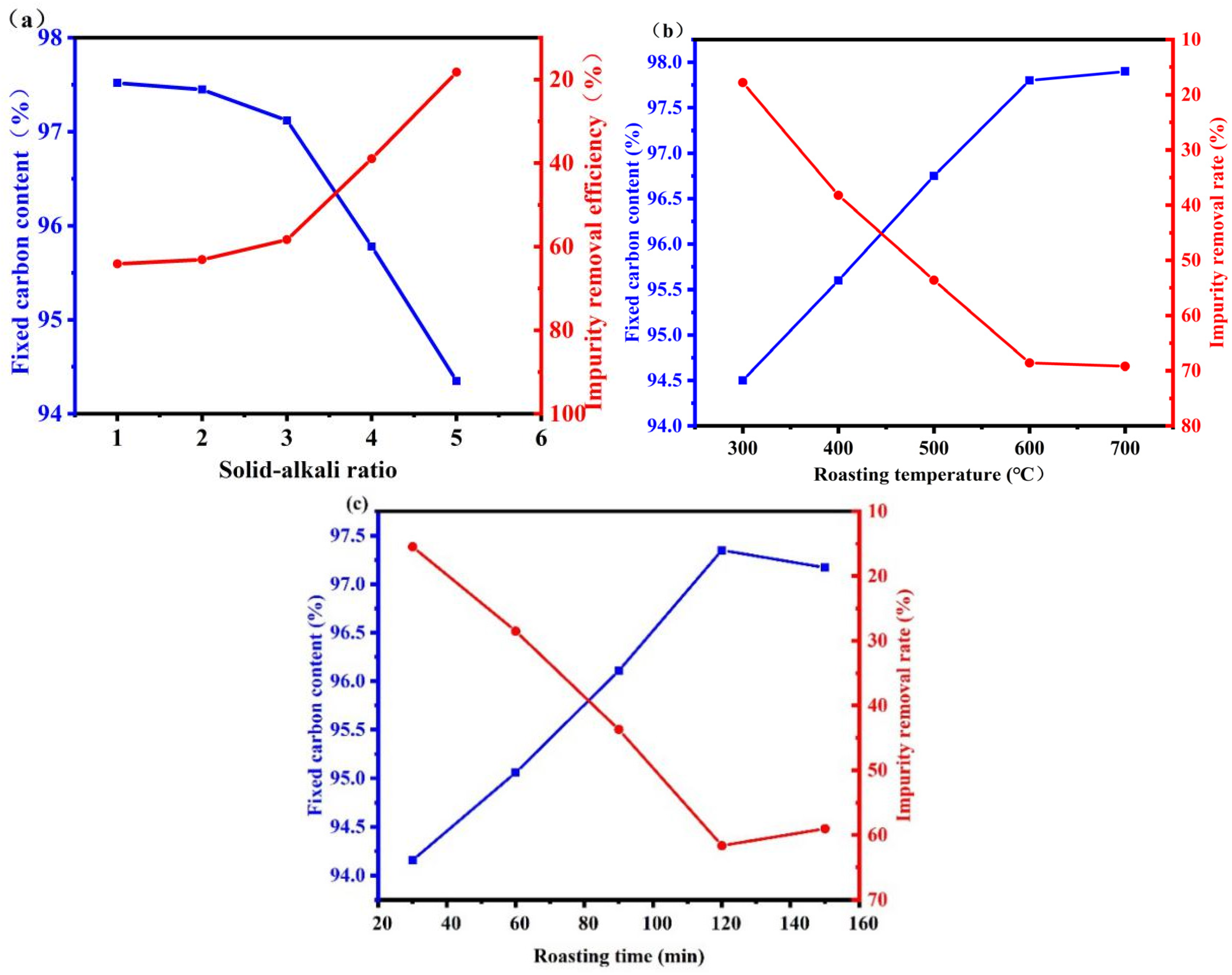
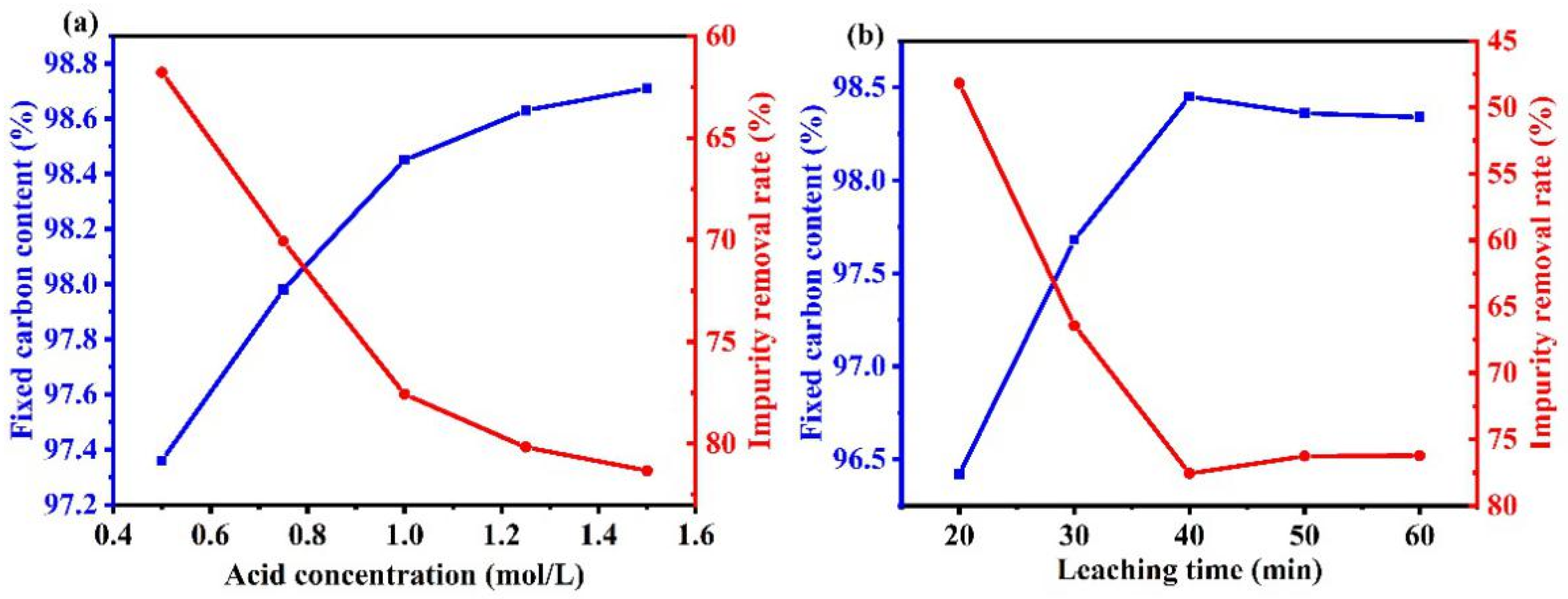
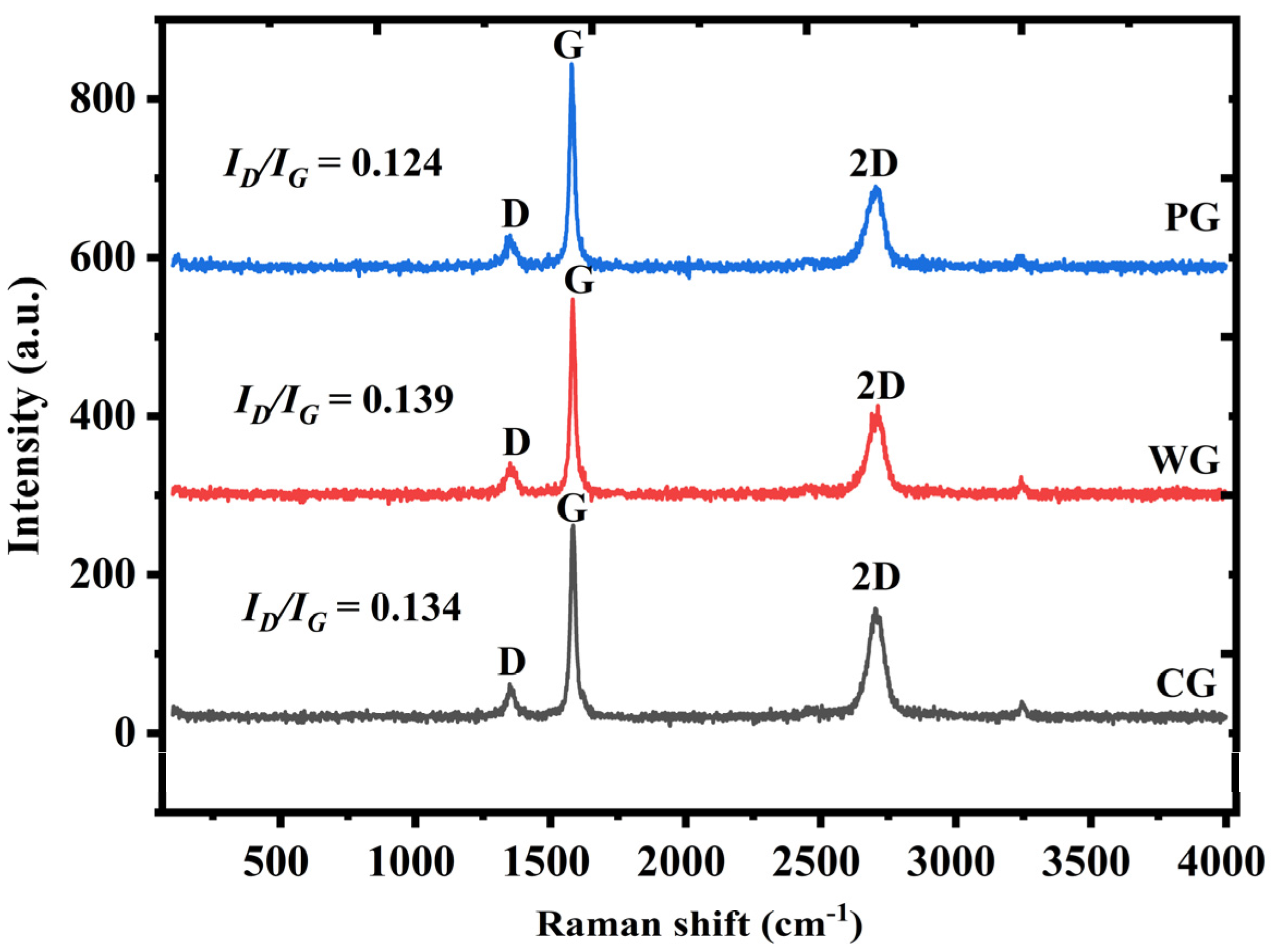
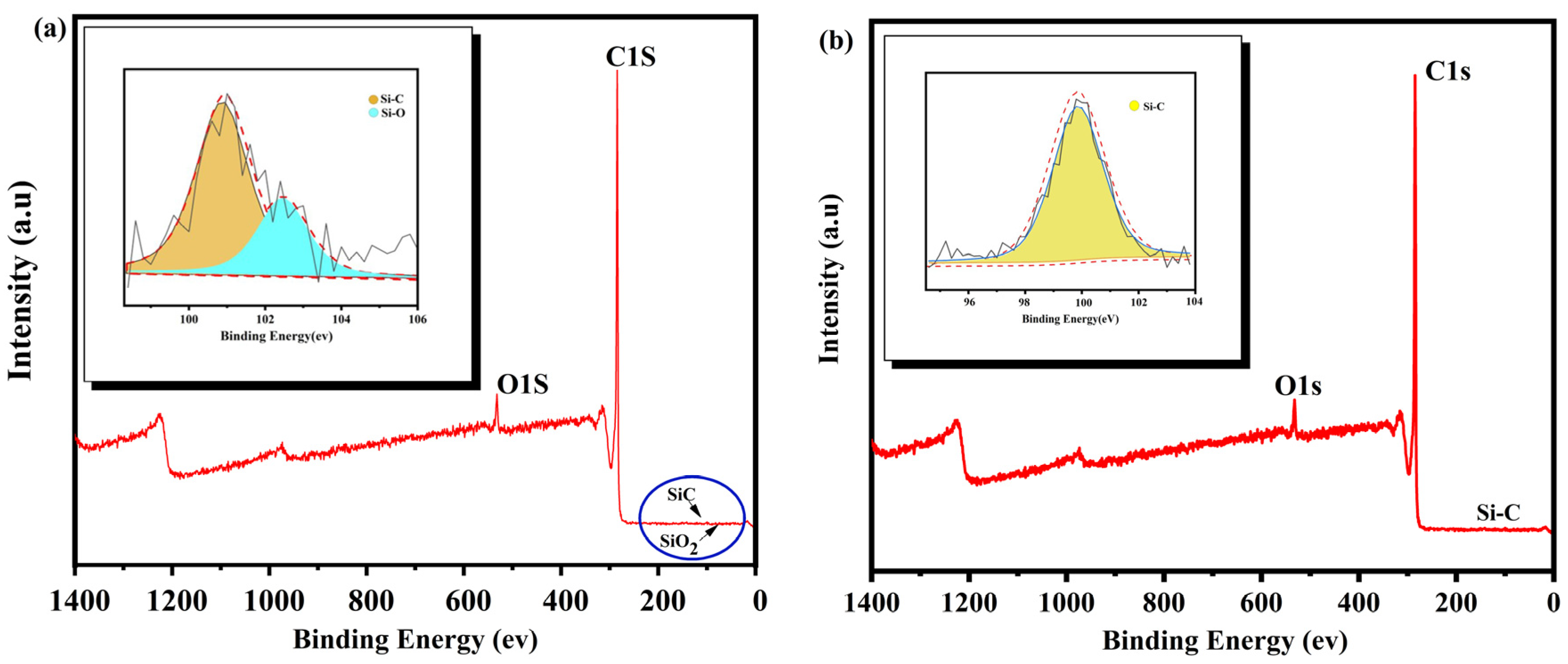
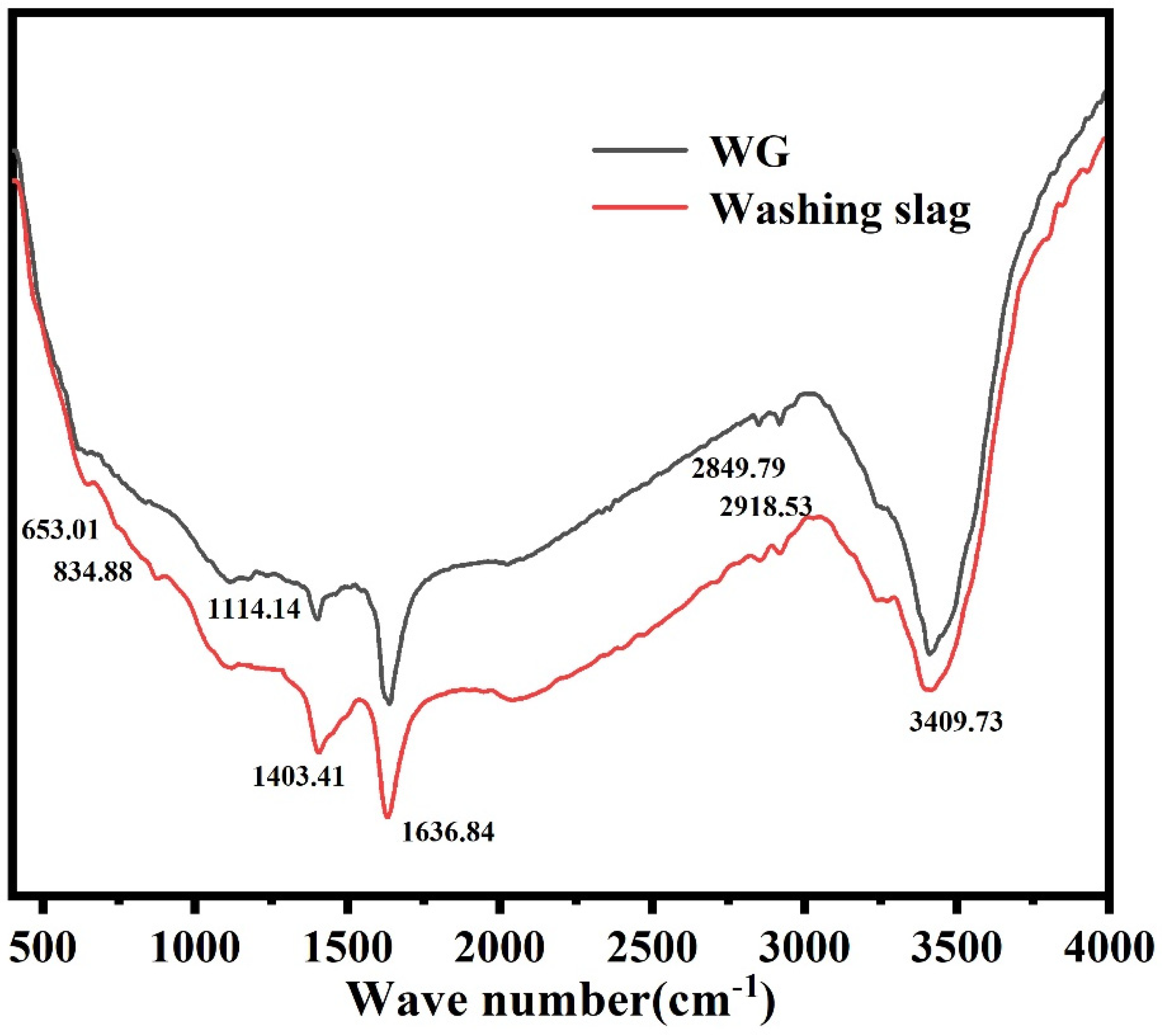
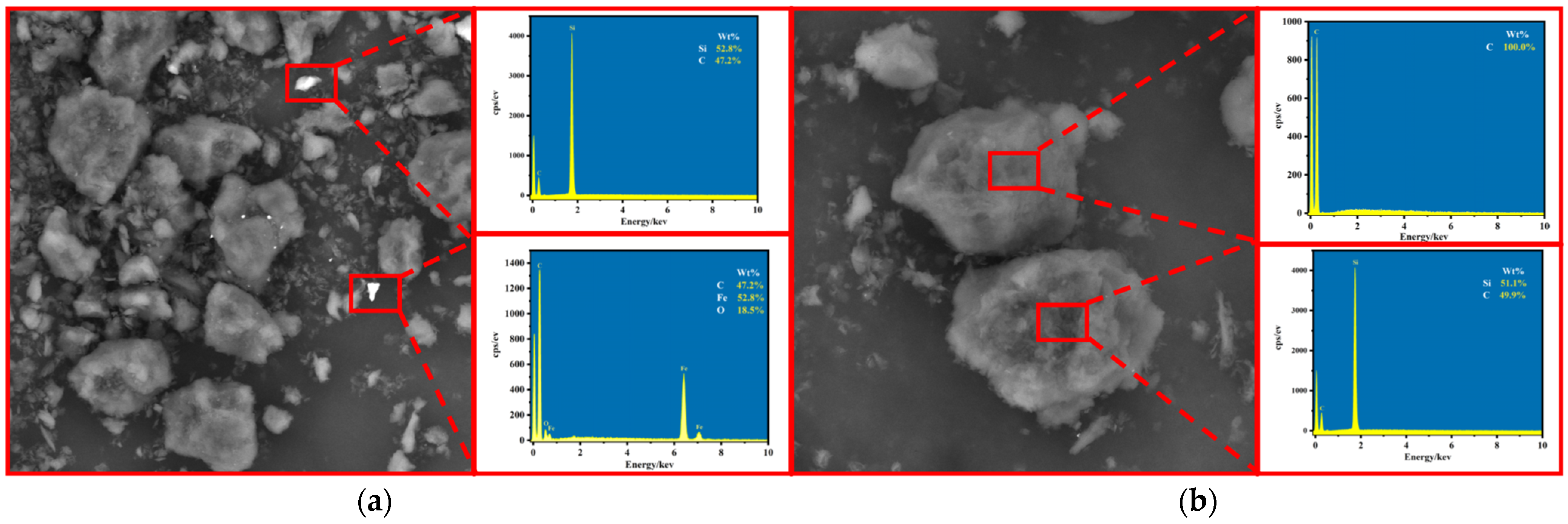
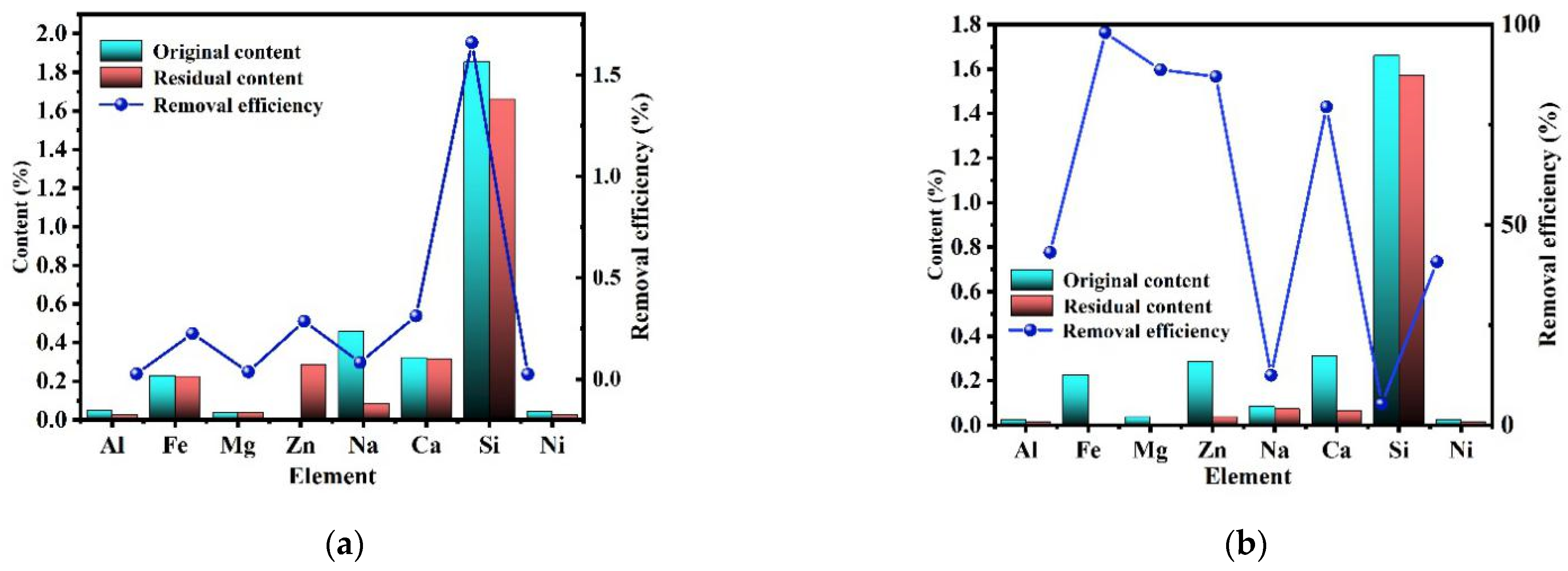
| Element | Si | Fe | Al | Mg | Zn | Ni | Ti | Ca | Na |
|---|---|---|---|---|---|---|---|---|---|
| Content (mg/Kg) | 18,533 | 2290 | 509 | 388 | 32.35 | 459 | 51.99 | 3225 | 4576 |
| Materials | Mad | Vad | Aad | FC |
|---|---|---|---|---|
| WG | <0.1 | 0.88 | 5.93 | 93.09 |
| Test Quality (g) | C | SiC |
|---|---|---|
| 0.1020 g | 26.66% | 4.74% |
| 0.0573 g | 25.75% | 4.58% |
Disclaimer/Publisher’s Note: The statements, opinions and data contained in all publications are solely those of the individual author(s) and contributor(s) and not of MDPI and/or the editor(s). MDPI and/or the editor(s) disclaim responsibility for any injury to people or property resulting from any ideas, methods, instructions or products referred to in the content. |
© 2023 by the authors. Licensee MDPI, Basel, Switzerland. This article is an open access article distributed under the terms and conditions of the Creative Commons Attribution (CC BY) license (https://creativecommons.org/licenses/by/4.0/).
Share and Cite
Zhang, Y.; Chen, Z.; Xie, K.; Chen, X.; Hu, Y.; Ma, W. Purification of Waste Graphite from Crucibles Used in Photovoltaic Crystallization by an Alkali-Acid Method. Metals 2023, 13, 1180. https://doi.org/10.3390/met13071180
Zhang Y, Chen Z, Xie K, Chen X, Hu Y, Ma W. Purification of Waste Graphite from Crucibles Used in Photovoltaic Crystallization by an Alkali-Acid Method. Metals. 2023; 13(7):1180. https://doi.org/10.3390/met13071180
Chicago/Turabian StyleZhang, Yonghang, Zhengjie Chen, Keqiang Xie, Xiaowei Chen, Yiyou Hu, and Wenhui Ma. 2023. "Purification of Waste Graphite from Crucibles Used in Photovoltaic Crystallization by an Alkali-Acid Method" Metals 13, no. 7: 1180. https://doi.org/10.3390/met13071180
APA StyleZhang, Y., Chen, Z., Xie, K., Chen, X., Hu, Y., & Ma, W. (2023). Purification of Waste Graphite from Crucibles Used in Photovoltaic Crystallization by an Alkali-Acid Method. Metals, 13(7), 1180. https://doi.org/10.3390/met13071180





